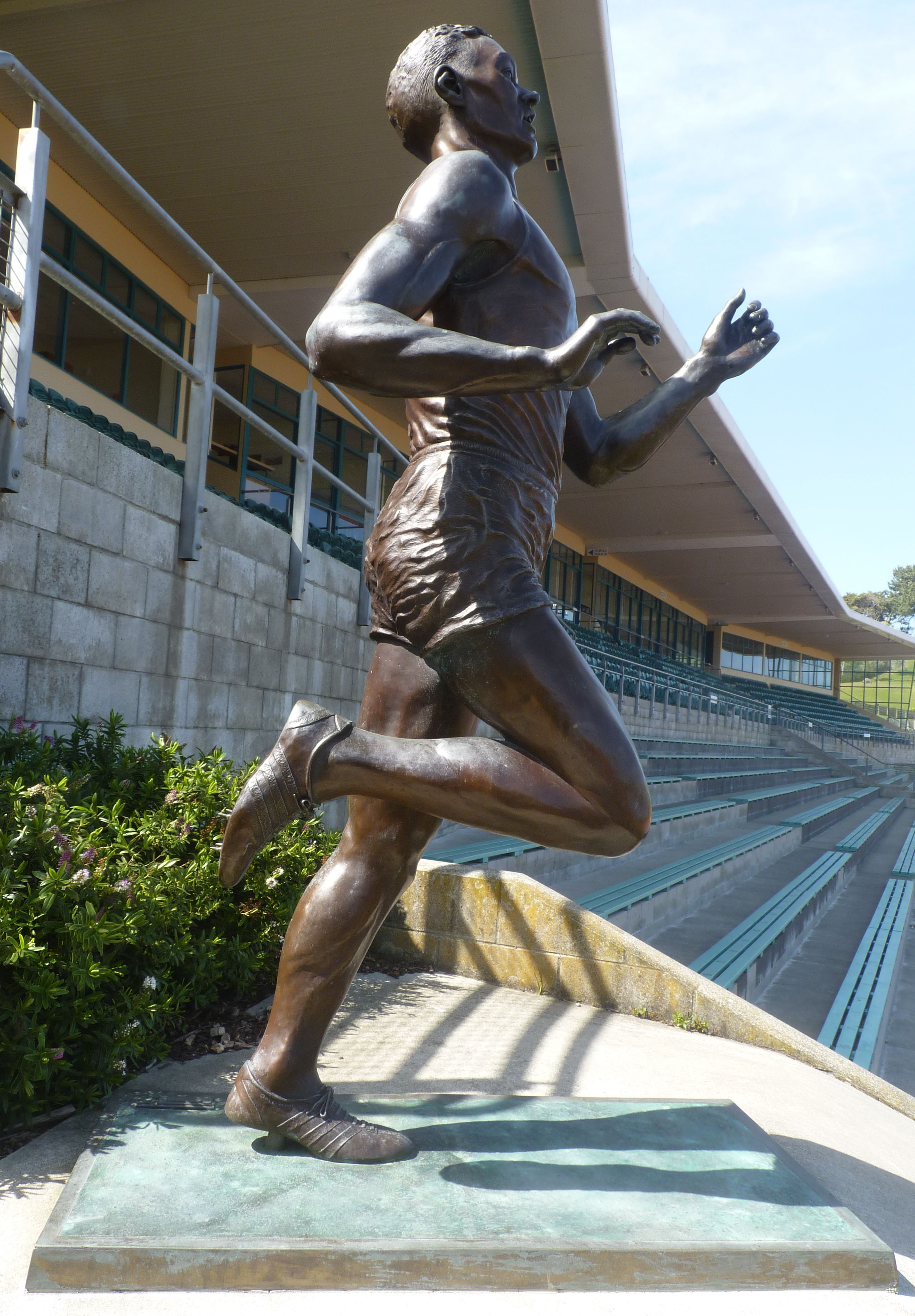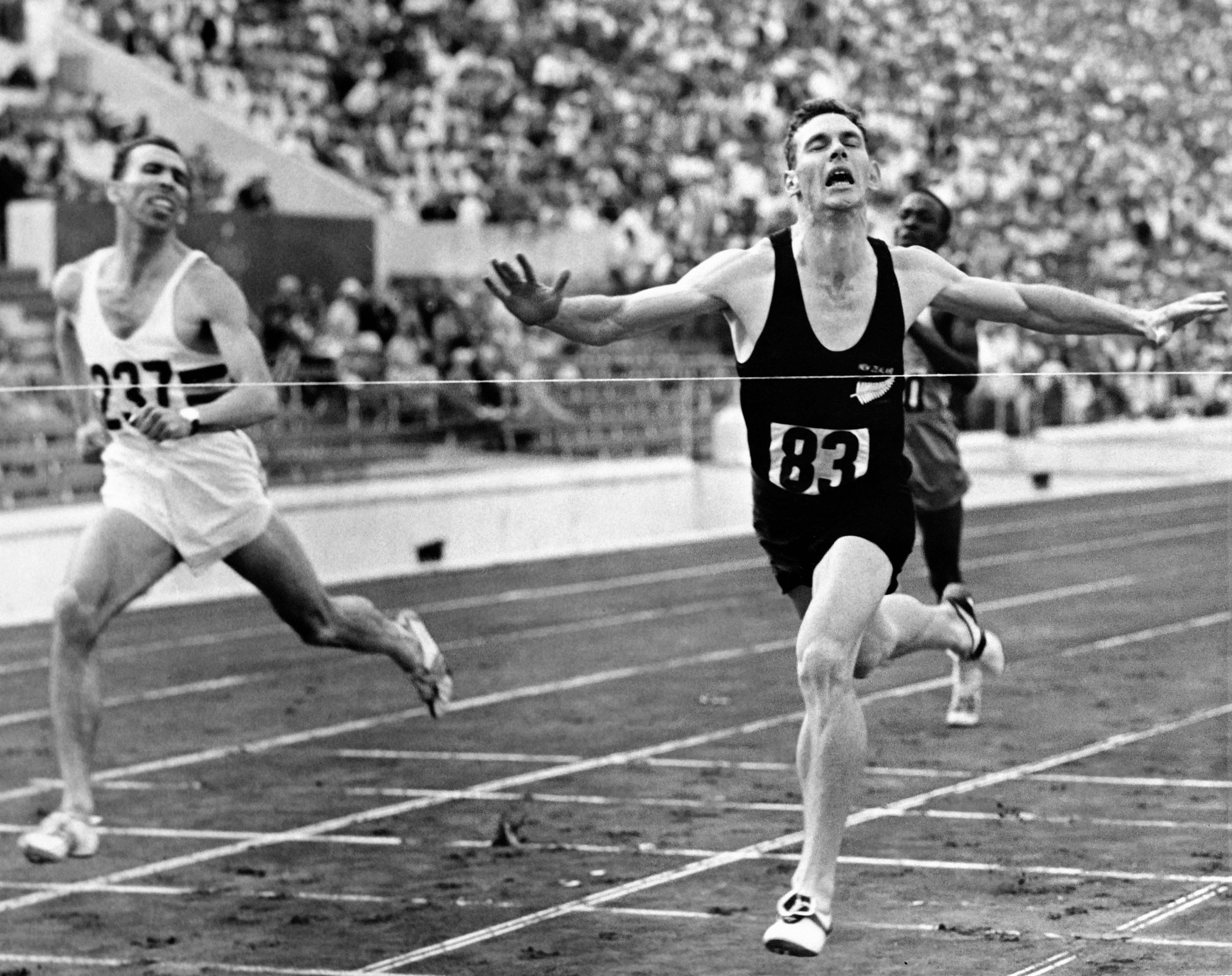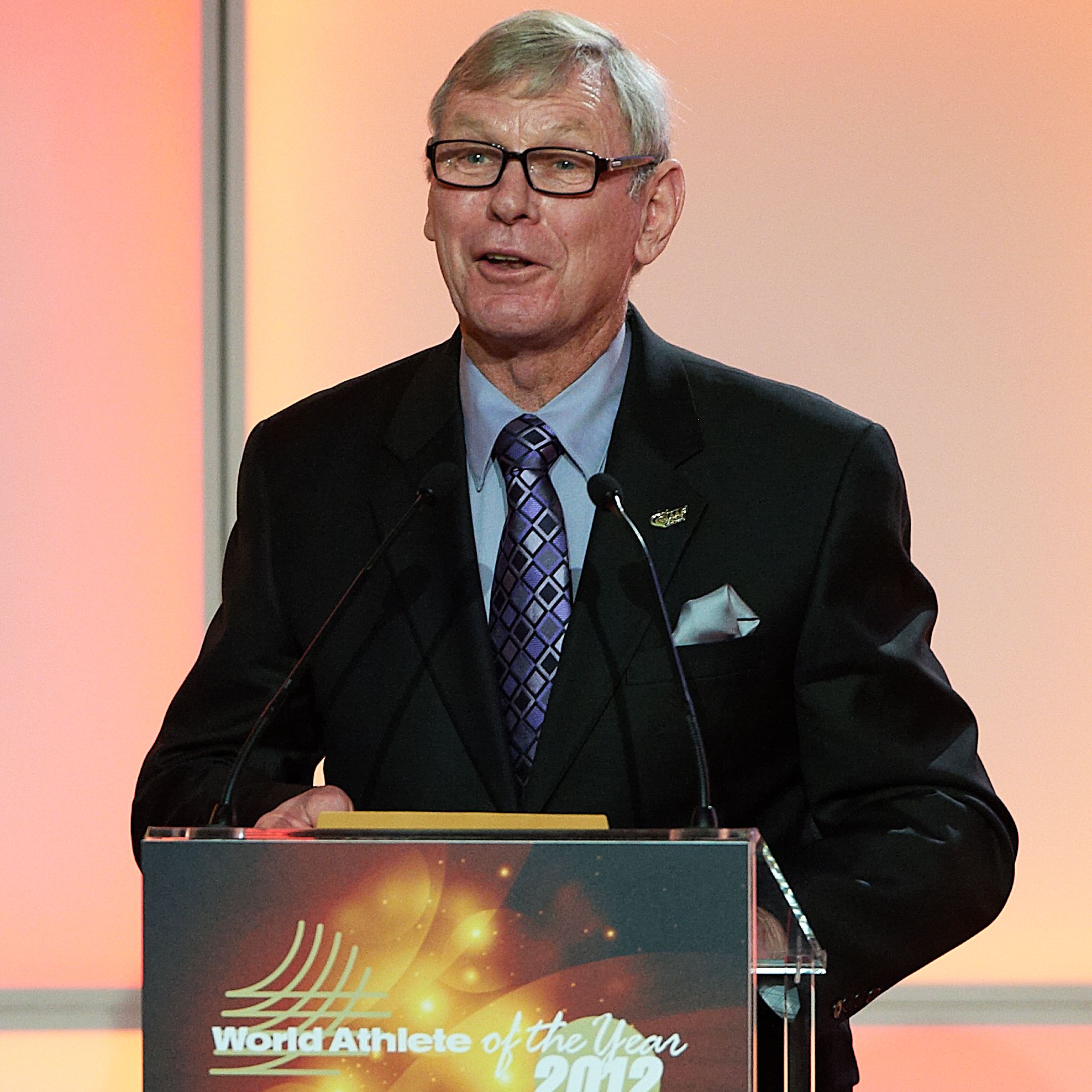Peter Snell breaks the mile world record at Cooks Gardens (© J Souter - Cooks Classic / Athletics New Zealand)
At the Cooks Gardens athletics track in Whanganui stands a life-size bronze statue of Peter Snell, frozen in time as he crosses the finish line opposite to enter the hallowed realm of world record breakers for the first time.

World Athletics is proud to mark the occasion with the award of a Heritage Plaque which will be installed at Cooks Gardens, which now boasts a synthetic track in place of the grass surface on which Snell powered his way to the first of his two world mile records.
• Announcement: Peter Snell and Cooks Gardens jointly honoured with the Heritage Plaque
‘Still a novice miler’
Like the very best world record performances, the story of Snell’s stunning 3:54.4 mile on home soil on 27 January 1962 was a tale of the unexpected.
True, he was a reigning Olympic champion, but that surprise success in Rome in 1960 had come as a breakthrough 800m runner. Two years on, the 23-year-old Kiwi was, in the words of his coach, the legendary New Zealand distance running guru Arthur Lydiard, “still a novice miler”.
Snell had clocked 4:01.2 at Timaru earlier in the New Zealand summer season and his goal in Whanganui, on the west coast of his homeland’s North Island, was purely to break four minutes. No one had ever achieved the feat on New Zealand soil.
Nobody was expecting an assault on the 3:54.5 world record figures set by Elliott, the peerless Australian Olympic 1500m champion, at Santry Stadium in Dublin in 1958. Secretly, Snell felt that if all went well he might possibly challenge the New Zealand record set in that race in the Irish capital by his training partner, Olympic 5000m champion Murray Halberg: 3:57.5.
The previous Saturday, Snell had won an 880 yards race in Auckland in a national record of 1:48.2. The following day, in blistering heat, he ran 22 miles around the Bombay Hills from his home in Pukekohe – maintaining his base stamina, as per the Lydiard philosophy – in preparation for the Whanganui mile.
There were no signs of fatigue in the 880 yards he contested in Hamilton on the Wednesday, three days before the Whanganui meet. Quite the contrary. Snell crossed the line in 1:47.1, breaking his national record by more than a second. Had he not eased his foot off the gas down the home straight, he might have broken US runner Tom Courtney’s five-year-old world record for the half-mile distance, 1:56.8.
Stars shine on Snell
When Saturday 27 January dawned with leaden skies and the heavens opening with a vengeance over most of New Zealand’s North Island, it seemed that Snell had sacrificed that global mark for the sake of a 4:05 plod around a muddy track.
In Whanganui, however, the rain just about held off as the spectators massed on the banked terrace encircling the Cook’s Gardens track.
As the esteemed New Zealand sportswriter Norman Harris recalled in his wonderfully evocative pen-portrait of the evening in Lap of Honour, “They sit there on the green banks, 16,000 strong, the sinking sun glowing in their faces and the black thunder clouds straight above them. Anywhere else but New Zealand and they might be gathering to await a religious pageant.
“The rain is still not falling. The sun sets and the lights are turned on, and back in the depths of the darkness a hundred cigarettes glow on the banks. The faintest trace of moisture falls from the sky and makes the grass shine…and then nothing. At nine o’clock, half an hour before the race, there is a break in the sky above. The stars are shining!”
At 9.30pm, Snell got to his marks with the rest of the mile field halfway down the back straight. On the odd-sized track of 385.85 yards (352.8m), there were 280 yards and then four laps to be run.
The seven-strong line-up included 800m runner Barry Cossar, who had agreed to set the pace in the first half of the race, and Halberg, who was expected to take over the burden to the three-quarters mark.
Crossar duly led through 440 yards in 60.7. Snell was seventh and last in 61.3 but swiftly moved up to third, reaching halfway in 2:00.8.
With Halberg struggling, Snell surged into the lead, Harris noting, “The length and ease of that slumbering stride of his puts all others to shame.”
The crowd roared when his time at the three-quarters mark was announced: 2:59.8. A collective gasp of surprise soon followed as the slender British runner Bruce Tulloh shot in front but Snell passed him and then launched into overdrive down the back straight.
“All eyes are on Snell, thousands of voices starting to shout for him,” Harris wrote. “He comes around the bend running gloriously. Faster still. Faster. And faster.
“The noise grows even louder; high above the roar there rises a vibrant shout for ‘Snell! Snell! Snell!’ The dust is bouncing off the arc lights with the noise of it.
“He has swung out of the bend, straightened up, fastened his eyes on the end of the straight, and now he is sprinting with his spikes digging into the turf. He is thundering down the straight with all the certainty of a tidal wave. He hits the tape in the onrush, runs yards through it.”
“For four minutes no announcement is made, while the crowd shout, clap and clamour. At last the loud-speaker crackles: ‘Here is the most amazing announcement ever made at Cook’s Gardens – Peter Snell has equalled the world record.’
“The tremors from Cook’s Gardens go right across Whanganui. Then, spontaneously, 16,000 voices start together on ‘For He’s A Jolly Good Fellow.’ The song has never been sung so enthusiastically.”
The announcer was wrong. The world record listed in the programme was 3:54.4. It should have been 3:54.5.
Snell pointed the error when he was interviewed by reporters at track side and the message was relayed to the announcer. When the correction was made public, and the world record finally announced, the crowd were “half demented”, as Harris put it.
The timekeepers worked out that Snell had covered the final 440 yards in 56.4, his splits being: 61.3, 59.5, 59.0 and 54.6. He had covered the last 118 yards in 14.6, matching the winning time in the preceding 110 yards hurdles.
Tulloh finished second in 3:59.3 and proceeded to become European 5000m champion in Belgrade later in the year. Australian Albie Thomas was third in 4:03.5 and Halberg fourth in 4:07.2.
World 800m record followed
Exactly a week later, on 3 February, Snell followed up with an even more stunning exploit: an 800m world record of 1:44.3 on the Lancaster Park grass track in Christchurch. It stood as a world record for 11 years and as the Oceania record for 56 years. It remains the New Zealand record, ahead of John Walker’s 1:44.92.
If Snell had achieved nothing else, his world record double of early 1962 would suffice to earn him track and field immortality. Yet he also compiled a formidable competitive record, losing several minor races but nailing victory in every one of his five major championship outings: the 1960 Olympic 800m in Rome, the 1962 Commonwealth 880 yards and mile in Perth, and the 1964 Olympic 800m and 1500m in Tokyo. His double in Tokyo was the first at the distances since Britain’s Albert Hill in Antwerp in 1920.
It was at the Rome Olympics that Snell dramatically announced his arrival on the world stage. He arrived as the new national 880 yards record-holder, with a time of 1:49.2, but as a 21-year-old unknown quantity to the wider world.

The 800m was expected to be a battle between world record-holder Roger Moens from Belgium and Jamaica’s George Kerr. Instead, the 5ft 10in, 13st Kiwi with the physique of an All Black rugby player powered past the despairing Moens in the final 25 metres to claim victory in 1:46.3, an Olympic record.
Four years later, in Tokyo, Snell destroyed the opposition with devastating bursts down the back straight, winning the 800m by half a second in 1:45.1, another Games record, and unleashing a 53.2-second last lap to take the 1500m by one-and-a-half seconds.
He also improved his mile world record to 3:54.1 in Auckland in November 1964 and clocked a 1000m world record of 2:16.6 in the same month.
‘It was all about the conditioning’
It all might not have been. Tennis was Snell’s first sporting love. He was a quarter-finalist in the New Zealand Under 17 championships.
Towards the end of his schooling he found that his powerful physique better suited him to running and his successes brought him into the orbit of Lydiard, a former New Zealand marathon champion, who persuaded him that a weekly training regime of 100 miles – including a Sunday 22 miler, as well as hill running and interval training – would equip him with the stamina base required to become a world-class 800m runner.

“I came to the conclusion that it was all about the conditioning,” Snell told Runner’s World. “Spend as much time as you can on the conditioning and you’ll eventually get yourself into, as Lydiard liked to say, a ‘tireless state’.
“You could run the 22-mile course and feel like you could go out the next day and do it again. Once you got there, it was a very heady feeling. You could do a great volume of training, get your intervals down to race pace, and do faster than race pace.”
Determined to the last
Snell retired from the track in 1965 and moved to the US in 1971, gaining a PhD in exercise physiology and becoming director of the Human Performance Center at the University of Texas in Dallas. His sporting success continued to late in his life.
In 2003 he won the 65 and over section at the US orienteering championships. At the age of 78 he won a team silver medal at the World Masters table tennis championships in Auckland in 2017.

On 20 November 2019, despite having suffered a heart attack a week earlier and against his doctor’s advice, Snell attempted to board a flight in Dallas determined to attend a reunion of world mile record-holders in Monaco. Feeling dizzy, Snell returned home.
On 12 December 2019, aged 80, Snell died of heart failure.
Vivid memories of his dashing deeds, at Cooks Gardens and beyond, live on.
Simon Turnbull for World Athletics Heritage




